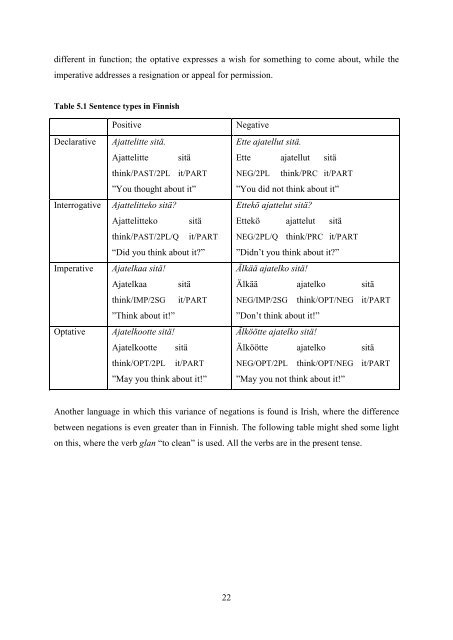The function of non-canonical imperatives in the languages of Europe
The function of non-canonical imperatives in the languages of Europe
The function of non-canonical imperatives in the languages of Europe
Create successful ePaper yourself
Turn your PDF publications into a flip-book with our unique Google optimized e-Paper software.
different <strong>in</strong> <strong>function</strong>; <strong>the</strong> optative expresses a wish for someth<strong>in</strong>g to come about, while <strong>the</strong><br />
imperative addresses a resignation or appeal for permission.<br />
Table 5.1 Sentence types <strong>in</strong> F<strong>in</strong>nish<br />
Declarative<br />
Interrogative<br />
Imperative<br />
Optative<br />
Positive<br />
Ajattelitte sitä.<br />
Ajattelitte sitä<br />
th<strong>in</strong>k/PAST/2PL it/PART<br />
”You thought about it”<br />
Ajattelitteko sitä<br />
Ajattelitteko sitä<br />
th<strong>in</strong>k/PAST/2PL/Q it/PART<br />
“Did you th<strong>in</strong>k about it”<br />
Ajatelkaa sitä!<br />
Ajatelkaa sitä<br />
th<strong>in</strong>k/IMP/2SG it/PART<br />
”Th<strong>in</strong>k about it!”<br />
Ajatelkootte sitä!<br />
Ajatelkootte sitä<br />
th<strong>in</strong>k/OPT/2PL it/PART<br />
”May you th<strong>in</strong>k about it!”<br />
Negative<br />
Ette ajatellut sitä.<br />
Ette ajatellut sitä<br />
NEG/2PL th<strong>in</strong>k/PRC it/PART<br />
”You did not th<strong>in</strong>k about it”<br />
Ettekö ajattelut sitä<br />
Ettekö ajattelut sitä<br />
NEG/2PL/Q th<strong>in</strong>k/PRC it/PART<br />
”Didn’t you th<strong>in</strong>k about it”<br />
Älkää ajatelko sitä!<br />
Älkää ajatelko sitä<br />
NEG/IMP/2SG th<strong>in</strong>k/OPT/NEG it/PART<br />
”Don’t th<strong>in</strong>k about it!”<br />
Älköötte ajatelko sitä!<br />
Älköötte ajatelko sitä<br />
NEG/OPT/2PL th<strong>in</strong>k/OPT/NEG it/PART<br />
”May you not th<strong>in</strong>k about it!”<br />
Ano<strong>the</strong>r language <strong>in</strong> which this variance <strong>of</strong> negations is found is Irish, where <strong>the</strong> difference<br />
between negations is even greater than <strong>in</strong> F<strong>in</strong>nish. <strong>The</strong> follow<strong>in</strong>g table might shed some light<br />
on this, where <strong>the</strong> verb glan “to clean” is used. All <strong>the</strong> verbs are <strong>in</strong> <strong>the</strong> present tense.<br />
22
















